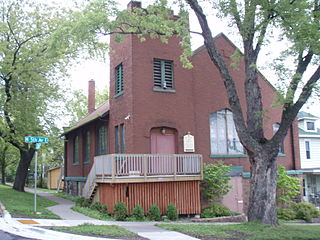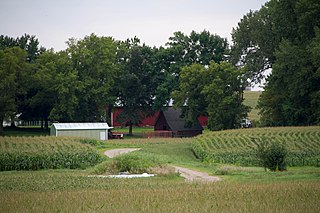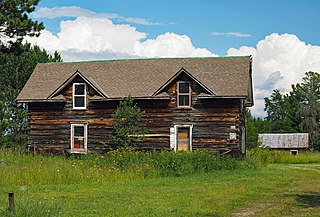
A barn is an agricultural building usually on farms and used for various purposes. In North America, a barn refers to structures that house livestock, including cattle and horses, as well as equipment and fodder, and often grain. As a result, the term barn is often qualified e.g. tobacco barn, dairy barn, cow house, sheep barn, potato barn. In the British Isles, the term barn is restricted mainly to storage structures for unthreshed cereals and fodder, the terms byre or shippon being applied to cow shelters, whereas horses are kept in buildings known as stables. In mainland Europe, however, barns were often part of integrated structures known as byre-dwellings. In addition, barns may be used for equipment storage, as a covered workplace, and for activities such as threshing.

The three University of Illinois round barns played a special role in the promotion and popularity of the American round barn. They are located in Urbana Township, on the border of the U.S. city of Urbana, Illinois and on the campus of the University of Illinois Urbana-Champaign. The University of Illinois was home to one of the Agricultural Experiment Stations, located at U.S. universities, which were at the heart of the promotion of the round barn. At least one round barn in Illinois was built specifically after its owner viewed the barns at the university. Though originally an experiment the three barns helped to lead the way for round barn construction throughout the Midwest, particularly in Illinois. The barns were listed as contributing properties to the U of I Experimental Dairy Farm Historic District, which was listed on the U.S. National Register of Historic Places in 1994.

The University of Wisconsin Dairy Barn is a building located on the campus of the University of Wisconsin–Madison. Built in 1897, the building played an important role in the field of dairy science during the 20th century. It has been used both as a teaching facility and as a site for agricultural research. It is significant for its association with the single-grain experiment, performed from 1907 to 1911 by Stephen Babcock. The UW Dairy Barn was declared a National Historic Landmark in 2005.

This is a list of the National Register of Historic Places listings in Saint Louis County, Minnesota. It is intended to be a complete list of the properties and districts on the National Register of Historic Places in Saint Louis County, Minnesota, United States. The locations of National Register properties and districts for which the latitude and longitude coordinates are included below, may be seen in an online map.

This is a list of the National Register of Historic Places listings in Olmsted County, Minnesota. It is intended to be a complete list of the properties and districts on the National Register of Historic Places in Olmsted County, Minnesota, United States. The locations of National Register properties and districts for which the latitude and longitude coordinates are included below, may be seen in an online map.

Oliver Green Traphagen was an American architect who designed many notable buildings in Duluth, Minnesota, during the late 19th century and in the Territory of Hawaii during the early 20th century. Among his most famous landmarks are the Oliver G. Traphagen House in Duluth, called the Redstone, and the Moana Hotel in Honolulu, both of which are on the National Register of Historic Places, as are several other buildings he designed.

Sacred Heart Cathedral, Sacred Heart School and Christian Brothers Home comprise a former Roman Catholic diocesan complex in the Central Hillside neighborhood of Duluth, Minnesota, United States. Sacred Heart Cathedral was built from 1894 to 1896 and served as the seat of the Roman Catholic Diocese of Duluth until 1957, after which it became a parish church. Sacred Heart School was built in 1904 and the Christian Brothers Home—a monastic residence for the school faculty—was built in 1907.

The Upper Peninsula Brewing Company Building is an office building located at the intersection of Meeske Street and US 41 in Marquette, Michigan. It is also known as the Charles Meeske House. The structure served as the home and office of brewer Charles Meeske, secretary-treasurer and later president of the company. It was listed on the National Register of Historic Places in 1980.

A housebarn is a building that is a combination of a house and a barn under the same roof. Most types of housebarn also have room for livestock quarters. If the living quarters are only combined with a byre, whereas the cereals are stored outside the main building, the house is called a byre-dwelling.

The Ed Eskelin Ranch is a historic residential and agricultural complex in Lake County, Oregon, United States. As a historic resource, the complex captures elements of two different phases of early 20th century settlement in the Fort Rock basin. It represents the perseverance and resourcefulness required of modest-scale ranchers and farmers in frontier conditions and during economic hardship. Architecturally, the ranch preserves excellent examples of the construction styles and knowledge in use by common homesteaders in the period, as well as elements of the Finnish cultural heritage of the region.

St. Mark's African Methodist Episcopal Church is a historic African Methodist Episcopal (AME) church in Duluth, Minnesota, United States. St. Mark's has played a central role in Duluth's African-American community for more than 125 years. While other black organizations have dissolved or moved to the Minneapolis–Saint Paul area, St. Mark's has been a local mainstay.

The Johann Schimmelpfennig Farmstead is a farm in Benton Township, Carver County, Minnesota listed on the National Register of Historic Places. The log and wood-framed buildings, built between 1856 and 1909, demonstrate the evolution of Minnesota farmsteads during that era.

A Gothic-arched roof barn or Gothic-arch barn or Gothic barn or rainbow arch is a barn whose profile is in the ogival shape of a Gothic arch. These became economically feasible when arch members could be formed by a lamination process. The distinctive roofline features a center peak as in a gable roof, but with symmetrical curved rafters instead of straight ones. The roof could extend to the ground making the roof and walls a complete arch, or be built as an arched roof on top of traditionally framed walls.

The Anna and Mikko Pyhala Farm is a historic farmstead in Embarrass, Minnesota, United States, now preserved as a visitor attraction. It was established by a Finnish-American family in 1909 and includes seven surviving buildings, including several constructed with traditional Finnish log architecture, and the ruins of a prior settler's log cabin dating to around 1895. The farm was listed as a historic district on the National Register of Historic Places in 2003 for its state-level significance in the themes of agriculture, architecture, and European ethnic heritage. It was nominated for being one of St. Louis County's best examples of a Finnish-American farm with log architecture, and for its association with Finnish immigration to northeast Minnesota and the conversion of its cutover forests into productive farmland.

The Erick and Kristina Nelimark Sauna is a historic Finnish sauna in Embarrass, Minnesota, United States. It was built around 1930. The sauna was listed on the National Register of Historic Places in 1990 for its state-level significance in the themes of agriculture, architecture, and European ethnic heritage. It was nominated for reflecting the area's settlement by Finnish American farmers and their use of traditional log construction.
The Mike and Mary Matson Farmstead is a historic farmstead in Embarrass Township, Minnesota, United States. It was established by a Finnish immigrant family around 1900 and includes five surviving buildings constructed with traditional Finnish log architecture. The farm was listed as a historic district on the National Register of Historic Places in 1990 for its state-level significance in the themes of agriculture, architecture, and European ethnic heritage. It was nominated for its association with the Finnish settlement and conversion of St. Louis County's cutover woodland into productive farmland, and for exhibiting their use of traditional log architecture.

The Gregorius and Mary Hanka Farmstead is a historic farmstead in Embarrass Township, Minnesota, United States. It was established by a Finnish immigrant family around 1910 and includes four surviving buildings constructed with traditional Finnish log architecture. The farm was listed as a historic district on the National Register of Historic Places in 1990 for its state-level significance in the themes of agriculture, architecture, and European ethnic heritage. It was nominated for reflecting the successful conversion of St. Louis County's cutover forests into productive agricultural land by Finnish immigrants, and their use of traditional log architecture.

The Elias and Lisi Aho Farmstead is a historic farmstead in Waasa Township, Minnesota, United States. It was established by a Finnish immigrant family and includes five surviving buildings constructed with traditional Finnish log architecture from 1902 to 1907. The farm was listed as a historic district on the National Register of Historic Places in 1990 for its state-level significance in the themes of agriculture, architecture, and European ethnic heritage. The Aho Farmstead was nominated for reflecting the successful cultivation of northeastern Minnesota's cutover forests by Finnish American settlers and their use of traditional log architecture.

Anton Werner Lignell was a Swedish-speaking Finnish architect known for designing buildings in Butte, Montana; Duluth, Minnesota; and two courthouses in Minnesota. His style tended towards Beaux-Arts as well as Tudor Revival and Gothic Revival.

Frederick George German was a Canadian-American architect who designed a number of notable buildings in Duluth, Minnesota.






















